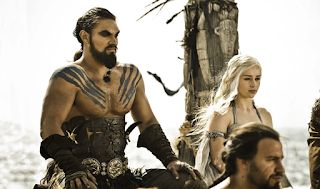A Long Time Ago, In a Medievalist Galaxy Far Far Away...
Once upon a time, there was a young, orphan farm boy, named Luke, who is raised by his aunt and uncle. But one day, Luke runs into two fugitives who tell him about a beautiful princess held captive by an evil Empire and its dark lord. With the help of a wise wizard, a dashing outlaw and his beastly companion, Luke endeavors on a quest to save the princess and defeat the dark lord. This fairy tale story is one that we are all very familiar with, and one that has had a profound and iconic impact on the current culture, in the same way that the fairy tales of old impacted their respective cultures. When writing the original Star Wars trilogy, George Lucas noted that there were no modern fairy tales, and set out to change that. Drawing from medieval literature and mythology, Lucas told us a classic story about a hero's journey, following closely to Joseph Campbell's model. I would also like to argue that Star Wars is actually much closer to fantasy than it is to its common label as science fiction. For example, there are the legendary Jedi, powerful individuals who have the ability of the Force and wield a laser sword. Opposite the Jedi, there are the Sith who are basically dark Jedi who use the gift of the Force for evil. I present the Force and its binary users as an example because of the essential element of the supernatural in all fantasy. Every fantasy story must have some sort of unexplained phenomena or power that has an drastic influence on the world. Just like wizards using magic, the Jedi and the Sith are the figures in this universe that are capable of harnessing this etherial force and using it to either keep peace or make war. This is the basis of the Star Wars universe, and it is this binary that Lucas' world and mythology is built on. This supernatural element found in all fantasy is essential to the fantasy label. That's why the idea of 'midi-chlorians" that was introduced in the prequels was so terrible and is completely ignored by the sequel trilogy. Explaining away the Force as a scientific, physical thing destroyed the magic and made Star Wars science fiction. But let's not dwell on that atrocity. Looking at the diegetic history of the Star Wars saga, it is easy to see the parallels it has the rise and fall of the Roman Empire and the beginning of the medieval world. The prequels begin with the Galactic Republic, a decentralized, democratic government led by a senate of representatives and a supreme chancellor. The Republic's purpose was to help keep peace between the independent, united systems, but when the Republic is threatened by the growing Separatist movement (orchestrated by Darth Sidious, the supreme chancellor) they become a much more centralized power, building up a standing clone army and giving special powers to the Supreme Chancellor in order to win the war. But, much like the Roman Republic, the democracy was overthrown and replaced by a supreme, galactic Empire. Three movies later, the Empire falls to the band of freedom fighters known as the Rebel Alliance, and despite the happy ending of Return of the Jedi, the galaxy is thrown into chaos. This mirrors the fall of the Roman Empire and the emergence of the medieval world on our modest planet. Not only does the story seem to parallel a lot of European history, but a lot of aesthetics chosen, particularly for the sequel trilogy, only add to this idea of medievalism in Star Wars. Kylo Ren's cross guard lightsaber and Maz Kanata's castle are a few examples of this. The Force Awakens also has a very medievalist story to tell about relics and hermits. Kylo Ren venerates Darth Vader, and even prays to his old helmet, a relic of the past. Not only that, but the whole story revolves around finding Luke Skywalker, who has hidden himself away as a hermit in isolation, and the mythical lightsaber that Rey finds in the chambers of Maz' castle. For me, I always saw Rey as a sort of Arthurian character discovering Excalibur and becoming a powerful hero. To top it off, Rey and Kylo Ren have a final confrontation in a snowy forest that just screams medievalism out loud. This theme has even carried over into the most recent film, The Last Jedi, with the sacred Jedi texts in the ruins of the Jedi temple that Luke has isolated himself to. I could keep going and delve into these further, but I have other homework to work on. Overall, it is my belief that Star Wars is not only a medievalist fantasy, but also a modern fairy tale that has been influenced by classic medieval myths and legends, and that is one of the reasons that it is so iconic in today's society.



Overall, I found this to be an extremely interesting interpretation of Star Wars. Though I feel it could have gone into more depth into distinguishing the fantasy elements and the fairy tale elements of the movie series, I can definitely see how a comparison to either can be made. It's interesting as it is probably the most noted space operas out there which is a very distinct SF category and yet I feel that the argument you made does give a good basis for it being considered another genre altogether. I also found the comparison to Arthurian legend compelling as it's something I would not have noticed, yet particularly with Rey's hero's journey it's something that is easily comparable.
ReplyDelete